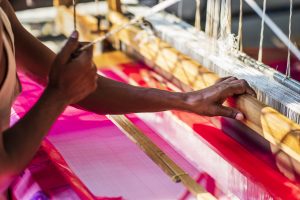Patola Saree
 Patola sarees are a traditional textile art form from the state of Gujarat in India. These sarees are renowned for their vibrant colors, intricate designs, and the unique double ikat weaving technique used in their creation. Patola sarees are considered to be one of the most valuable textiles in India, symbolizing cultural heritage, artistic craftsmanship, and luxury. They are closely associated with the Jain community, who have been involved in the production and trade of these sarees for generations.
Patola sarees are a traditional textile art form from the state of Gujarat in India. These sarees are renowned for their vibrant colors, intricate designs, and the unique double ikat weaving technique used in their creation. Patola sarees are considered to be one of the most valuable textiles in India, symbolizing cultural heritage, artistic craftsmanship, and luxury. They are closely associated with the Jain community, who have been involved in the production and trade of these sarees for generations.
Key Features of Patola Sarees:
Double Ikat Weaving: The most distinctive feature of Patola sarees is the “double ikat” weaving technique. In this process, both the warp (lengthwise threads) and weft (widthwise threads) are tied and dyed separately before being woven together. This creates symmetrical patterns on both sides of the fabric, making Patola sarees reversible.
Intricate Designs: Patola sarees are known for their intricate and geometric designs, often inspired by traditional motifs such as flowers, parrots, elephants, and human figures. The patterns are meticulously created by tying and dyeing the yarns in specific arrangements, resulting in complex and visually stunning designs.
Rich Color Palette: Patola sarees are known for their bold and vibrant color combinations. The use of natural dyes imparts a rich and enduring hue to the fabric. Each color is meticulously chosen, and the dyeing process involves several steps to achieve the desired shades.
also read about Indian Sarees and Types
History of Patola Saree
The origins of Patola sarees can be traced back to ancient India, particularly to the region of Patan, in the state of Gujarat. The word “Patola” is derived from the Sanskrit word “Pattakulla,” which means “a silk cloth.” The art of weaving Patola sarees is believed to have started during the era of the Solanki dynasty, which ruled Gujarat from the 10th to 13th century AD. Initially, it was practiced by skilled artisans, who used natural dyes and traditional weaving techniques to create these intricate textiles.
The development and propagation of Patola sarees were significantly influenced by the Jain community in Gujarat. Jain merchants played a pivotal role in the production, development, and trade of these exquisite textiles. Some of the finest Patola sarees were commissioned by Jain families and used as prestigious gifts or offerings during religious ceremonies and festivals. Over the centuries, Patola sarees gained immense popularity and became a symbol of wealth, status, and cultural pride. The intricate designs, vibrant colors, and exceptional craftsmanship made them highly sought-after by royalty, nobility, and wealthy merchants.

Manufacturing of Patola sarees
Patola sarees’ traditional techniques and intricate designs have been preserved through the efforts of dedicated weaver communities.
- Designing: The process begins with the design creation. The intricate patterns are charted out on graph paper, and the artisans carefully plan the placement of each motif. The designs are often inspired by traditional geometric and floral motifs.
- Yarn Selection: High-quality silk yarn is chosen for making Patola sarees. The yarn is usually imported from other regions or countries to ensure the finest texture and luster.
- Preparing the Warp and Weft: The warp and weft threads are carefully measured, and the number of threads required for each color and pattern is determined. The threads are aligned and tied in bundles, as they will need to be dyed in specific colors.
- Dyeing: The unique feature of Patola sarees is the double ikat technique, where both the warp and weft threads are individually tied and dyed before weaving. The threads are tied with precision to create the desired patterns. The dyers skillfully apply natural dyes in specific sections, ensuring that the colors match perfectly when woven together.
- Ikat Tie-Dyeing: The tie-dyeing process is repeated multiple times, depending on the complexity of the design. Each time, the threads are carefully tied and dyed to create different parts of the pattern. The process requires meticulous accuracy, as any misalignment can affect the overall design.
- Setting up the Loom: Once the dyed threads are ready, the loom is set up. The warp threads are stretched vertically on the loom, and the weaver skillfully interlaces the dyed weft threads in the desired patterns.
- Weaving: The weaving process is intricate and requires the weaver’s skill and patience. The weft threads are carefully woven through the warp threads, following the design chart. As the weaving progresses, beautiful patterns emerge on the fabric.
- Finishing: After completing the weaving, the saree is carefully inspected for any imperfections. The edges are neatly finished, and the saree is given its final touches.
The making of Patola sarees is an intricate and time-consuming process that involves several painstaking steps. Each saree is a masterpiece of craftsmanship and requires skilled artisans to bring the designs to life. The entire process of making a Patola saree can take several months, depending on the complexity of the design and the skill of the weaver.
Challenges and Revival
By the 19th century, the demand for Patola sarees began to decline due to various factors. The emergence of modern machinery and the availability of cheaper alternatives in the textile industry posed significant challenges to the traditional handloom craft. Additionally, political and economic changes in the region affected the patronage of artisans.
In the early 20th century, several individuals and organizations recognized the importance of preserving traditional crafts like Patola weaving. Efforts were made to revive the art form and create awareness about its cultural significance. Weaver cooperatives and government initiatives were established to support artisans and promote their craft.
In 2016, the art of making Patola sarees was inscribed on UNESCO’s Representative List of the Intangible Cultural Heritage of Humanity. This recognition highlighted the cultural importance and craftsmanship of Patola weaving and brought international attention to this traditional art form.
also read about Indian Sarees and Types



